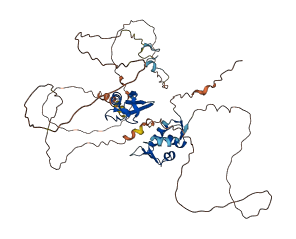Descriptions
Autoinhibitory domains (AIDs)
Target domain |
22-105 (SWIB/MDM2 domain) |
Relief mechanism |
Partner binding |
Assay |
|
Accessory elements
No accessory elements
Autoinhibited structure

Activated structure

1 structures for A0A4W3GZU3
| Entry ID | Method | Resolution | Chain | Position | Source |
|---|---|---|---|---|---|
| AF-A0A4W3GZU3-F1 | Predicted | AlphaFoldDB |
No variants for A0A4W3GZU3
| Variant ID(s) | Position | Change | Description | Diseaes Association | Provenance |
|---|---|---|---|---|---|
| No variants for A0A4W3GZU3 | |||||
No associated diseases with A0A4W3GZU3
1 GO annotations of cellular component
| Name | Definition |
|---|---|
| nucleus | A membrane-bounded organelle of eukaryotic cells in which chromosomes are housed and replicated. In most cells, the nucleus contains all of the cell's chromosomes except the organellar chromosomes, and is the site of RNA synthesis and processing. In some species, or in specialized cell types, RNA metabolism or DNA replication may be absent. |
1 GO annotations of molecular function
| Name | Definition |
|---|---|
| metal ion binding | Binding to a metal ion. |
2 GO annotations of biological process
| Name | Definition |
|---|---|
| negative regulation of apoptotic process | Any process that stops, prevents, or reduces the frequency, rate or extent of cell death by apoptotic process. |
| regulation of cell cycle | Any process that modulates the rate or extent of progression through the cell cycle. |
No homologous proteins in AiPD
| UniProt AC | Gene Name | Protein Name | Species | Evidence Code |
|---|---|---|---|---|
| No homologous proteins | ||||
| 10 | 20 | 30 | 40 | 50 | 60 |
| MTTASTSNPY | PSSDILCGNS | TEKIRPKPLL | LNLLHEAGAS | GEIFTLKEVM | HYLGQYIMLK |
| 70 | 80 | 90 | 100 | 110 | 120 |
| QLYDKQQQHI | VYCGNDPLGK | VFGVESFSVK | VPSQLYEMLS | RNLIALNFHD | AAQTRTLVKE |
| 130 | 140 | 150 | 160 | 170 | 180 |
| TNCLPLREEH | LKCLTGETSE | GETVCIVPNS | ATSHLKRKNS | ESDDLDADDQ | PELQSKRQRS |
| 190 | 200 | 210 | 220 | 230 | 240 |
| ESVSDHWDAA | GLPWWFIKSL | QSNYGSRKSG | STDIHSNQDI | DTAIVSDSTD | DLWFLNEPDH |
| 250 | 260 | 270 | 280 | 290 | 300 |
| DQANVEIKEG | AIHPKEIRDQ | EEEKEEDKNT | DPKEVIEVTI | YEAGEGLSCS | GHATDPEISD |
| 310 | 320 | 330 | 340 | 350 | 360 |
| KSWKCTKCGE | DNPSQKQYCL | QCWALRGGWH | LKCPKLTRST | SGPSIAIAEN | EPYEGIDVPD |
| 370 | 380 | 390 | 400 | 410 | 420 |
| SKRSISEPVI | QIKDLKCKEM | GIISTPCASS | ESLDSLSQPS | TSSLWRSRED | LESVGKEAKT |
| 430 | 440 | 450 | 460 | 470 | 480 |
| VKRKCEDSLQ | SRRQRLGPCL | ICGVRPRTGN | IIHRKMGHLV | ACYTCAKSLY | KRKMPCPVCV |
| 490 | |||||
| QPIIMVIQTF | IG |
